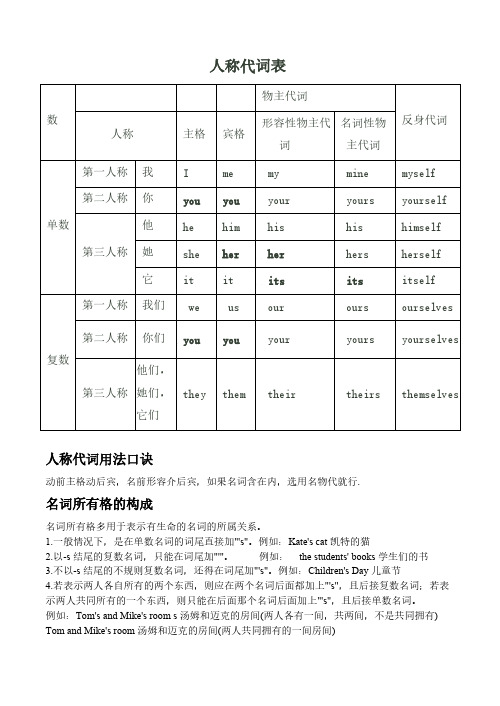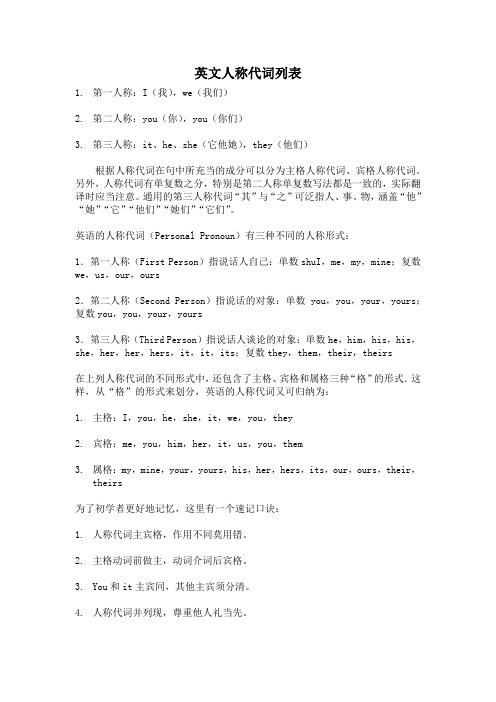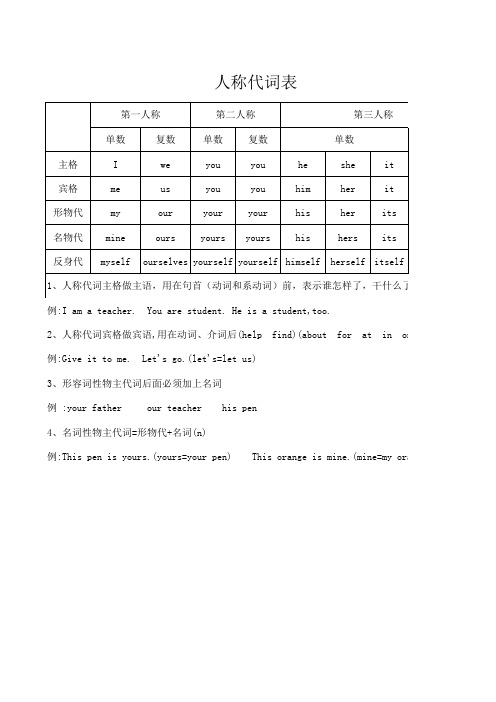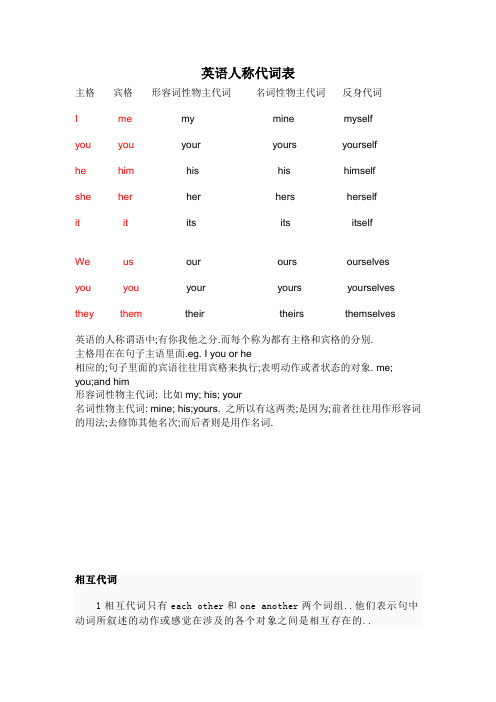人称代词表
人称代词表

英语名词单数变复数的规则:(动词的第三人称单数和它类似)
1、绝大多数的可数名词的复数形式,是在该词末尾加上后辍-s。 读音变化:结尾是清辅音读[s],结尾是浊辅音或元音读[z]。 2、凡是以 s、x、ch、sh 结尾的词,在该词末尾加上后辍-es 构成复数。 读音变化:统一加读[iz]。 例:bus→buses; box →boxes; watch →watches; actress →actresses; class →classes; coach →coaches; dress →dresses; sandwich →sandwiches; waitress →waitresses 3、以辅音字母+y 结尾的名词,将 y 改变为 i,再加-es。 例:candy→candies story→stories dictionary →dictionaries; activity →activities 4、以-o 结尾的名词,有生命的加 es,无生命的加 s. 例:tomato→tomatoes; potato→potatoes; photo→photos; 5、以-f 或-fe 结尾的名词,将-f 或-fe 改变为-ves,但有例外。 例:knife→knives; scarf(围巾)→scarves (动词的第三人称单数和前四条类似)
名词所有格的构成
名词所有格多用于表示有生命的名词的所属关系。 1.一般情况下,是在单数名词的词尾直接加"'s"。例如:Kate's cat 凯特的猫 2.以-s 结尾的复数名词,只能在词尾加"'"。 例如: the students' books 学生们的书 3.不以-s 结尾的不规则复数名词,还得在词尾加"'s"。例如:Children's Day 儿童节 4.若表示两人各自所有的两个东西,则应在两个名词后面都加上"'s",且后接复数名词;若表 示两人共同所有的一个东西,则只能在后面那个名词后面加上"'s",且后接单数名词。 例如:Tom's and Mike's room s 汤姆和迈克的房间(两人各有一间,共两间,不是共同拥有) Tom and Mike's room 汤姆和迈克的房间(两人共同拥有的一间房间)
英语人称代词表格

人称代词表格
一、人称代词
表示“我”、“你”、“他”、“她”、“它”、“我们”、“你们”、“他们”的词,叫做人称代词;人称代词有人称、数和格的变化,见下表:
人称代词主格:作主语,表示谁怎么样了、干什么了;
I am a teacher. You are student. He is a student, too.
We/You/They are students.
人称代词宾格作宾语,表示动作行为的对象;
Give it to me. Let’s go let’s =let us
二、物主代词
表示所有关系的代词叫做物主代词,也可叫做代词所有格;物主代词分形容词性物主代词和名词性物主代词二种,其人称和数的变化见下表;
形容词性物主代词my/your/his/her/its/our/their+名词
而名词性物主代词则相单于形容词性物主代词+名词,故其后不必加名词;如:
Is this your book
No,,it isn’t, it’s hersher book
This pen is mine.。
英语人称代词表格

英语人称代词表格人称代词表格人称代词人称第一人称第二人称单数第三人称我你他她它第一人称复数第二人称第三人称主格iyouhesheitwe宾格meyouhimheritusyouthem物主代词形容性名词性物主代词物证代词myyourhisheritsouryourtheirmineyourshishersitsoursyourstheirs反身代词myselfyourselfhimselfherselfitselfourselvesyourselvesthemselves我们你们you他/她/they它们----------------------------对------八折-----------------------人称代词表格人称代词人称第一人称第二人称单数第三人称我你他她它第一人称复数第二人称第三人称1物主代词主格宾格形容性物主代词名词性物证代词反身代词我们你们他她它们unit5doyouhaveasoccerball?一.学习重点【句型】1.doyouhaveatv?yes,ido./no,idon’t.6.idon’thaveasoccerball.8.thatsoundsgood.【知识点】1:have,has的用法2:therebe与have的区别3.一般疑问句:特殊疑问句:疑问词:who_______where_________how________what___________三.典型例解()1.―____isyourteacher?―it’smissgao.a.whatb.whoc.whered.how()2.tonyandiareg oodfriends,butweareindifferent____.a.classesb.schoolc.graded.age()3.herhair___ _blackandlong.a.hasb.amc.isd.are()4.―____wangfanghavetwosmalleyes?―no,shehas twobigeyes.a.doesb.doc.isd.are()6.―doesliyinghaveasmallmouth?―no,shehasawide ____.a.itb.themc.oned.ones()7i____abignose,buthe____asmallnose.a.have;haveb.ha ve;hasc.has;hasd.has;have()8.―dothetwoboyshavebignoses?―____a.yes,theyare.b.no,theyaren’t.c.no,theyhavebigones.d.yes,theydo.四.1.lilyandliz___________acat.a.have2.―doy―3.――4.ida.has;5.theydon'thave____ _______colourpencils,butihave___________§k]26.――9.――10.――11.――12.――ry;excusem1.ihavesomebaseballbats?(改为一般疑问句,并作肯定回答2.wehaveabigtvinourhouse?(改成否定句__3.shehasmanythingstodotoday.(改为一般疑问句,并作否定回答4.katehassomemoneyinherpocket.(改成否定句5.myparentshavefivegoodfriends.(就划线部分提问ⅲ、用have或has填空题b:ithinkhe__2.therearesomechildrenintheroom.theyall___________newbooks.buttheydon't___________anycolourpencils.leihao___________abigpencil-box.renlijuan___________asmallone.whataboutbaijie?oh,unit6doyoulikebananas?一.翻译讨厌___________薯条___________冰淇淋___________五个西红柿___________一些草莓___________三个汉堡___________九个香蕉___________四个男人___________一些花___________吃早饭___________许多;大量___________健康食品__________一位跑步明星__________good(副词)_________health(形容词)_________tomato(复数)_______1.我们一天喝三顿饭。
英语人称代词表格完整

英语人称代词表格(可以直接使用,可编辑实用优秀文档,欢迎下载)后附空白表格可下载打印由孩子填写人称代词表格人称代词表格英语人称代词(含反身代词)表及基础练习用法点击:1. 主格和宾格:I like you. They hit us.主格 宾格2.◆形容词性物主代词其后必须跟名词。
1)形容词性物主代词不能单独使用,后面必接名词,表示所有.如:• my pen 我的钢笔 your bag 你的书包 his bike 他的自行车 her desk 她的书桌 its name 它的名字 例句:Is that your bike? 那是你的自行车吗?Those are our books. 那些是我们的书。
◆如果名词前有形容词性物主代词,就不能同时用冠词(a, an,the)或指示代词(this, that, these, those)修饰此名词。
• [正]This is my pencil. [误]This is my a pencil. • [正]This is a pencil. [误] This is a my pencil.◆形容词性物主代词与形容词一起修饰名词时,要放在形容词之前。
如:his English books 他的英语书their Chinese friends 他们的中国朋友形容词性物主代词与名词性物主代词之间的关系为:例如:Your bedroom(=yours) is big.Mine (=My bedroom) is big, too. 你的卧室大。
我的卧室也大。
注意:在使用名词性物主代词时,必须有特定的语言环境,也就是要省略的名词大家已经知道,已经提起过。
例:It’s hers. 是她的。
(单独使用大家不知是怎么回事,不可以这样用)There is a book. It’s hers. 那有本书。
是她的。
(先提及,大家才明白)特别提醒:汉语表达常有省略“的”字的习惯,如:我哥哥、你们老师。
人称表

人称代词表格
人称代词 数 第一人称 第二人称 单数 第三人称 人称 我 你 他 她 它 第一人称 复数 第二人称 第三人称 我们 你们 他们 她们它 们 主格 I you he she it we you they 宾格 me you him her it us you them 物主代词 所有格,形容性物 主代词 my your his her its our your their 名词性 物主代词 mine yours his hers its ours yours theirs
人称代词表格 人称代词 数 人称 第一人称 第二人称 单数 第三人称 我 你 他 她 它 第一人称 复数 第二人称 第三人称 我们 你们 他们 她们它 们 主格 I you he she it we you they 宾格 me you him her it us you them 物主代词 所有格,形容性物 主代词 my your his her its our your their 名词性 物主代词 mine yours his hers its ours yours theirs
人称代词表格
人称代词 数 第一人称 第二人称 单数 第三人称 人称 我 你 他 她 它 第一人称 复数 第二人称 第三人称 我们 你们 他们 她们它 们 主格 I you he she it we you they 宾格 me you him her it us you them 物主代词 所有格,形容性物 主代词 my your his her its our your their 名词性 物主代词 mine yours his hers its ours yours theirs
人称代词表格
人称代词 数 第一人称 第二人称 单数 第三人称 人称 我 你 他 她 它 第一人称 复数 第二人称 第三人称 我们 你们 他们 她们它 们 主格 I yo her it us you them 物主代词 所有格,形容性物 主代词 my your his her its our your their 名词性 物主代词 mine yours his hers its ours yours theirs
人称代词表

(我的)
your
(你的)
his(他的)
her(她的)
its(它的)
our
(我们的)
your
(你们的)
their
(他们的)
名词性
mine
(我的)
yours
(你的)
his(他的)
hers(她的)
its(它的)
ours
(我们的)
yours
(你们的)
theirs
(他们的)
指示代词
this(这,这个),that(那,那个)
(他们)
宾格
me
(我)
you
(你)
him(他)
her(她)
it(它)
us
(我们)
you
(你们)
them
(他们)
物主
代词
形容词性
my
(我的)
your
(你的)
his(他的)
her(她的)
its(它的)
our
(我们的)
your
(你们的)
their
(他们的)
名词性
mine
(我的)
yours
(你的)
his(他的)
★★★看谁背得快:代词表
单数
复数
第一
人称
第二
人称
第三
人称
第一
人称
第二
人称
第三
人称
人称
代词
主格
I
(我)
you
(你)
he(他)
she(她)
it(它)
we
(我们)
you
(你们)
they
人称代词表

人称代词表人称代词表格数人称代词物主代词反身代词人称主格宾格所有格,形容性物主代词名词性物主代词单数第一人称 我 I me my mine myself 第二人称 你 you you your yoursyourself第三人称他he him his hishimself她she her her hersherself它 it it its its itself 复数第一人称 我们 we us our oursourselves第二人称 你们 you you your yoursyourselves第三人称他们,她们,它们 theythemtheirtheirsthemse lves形容词性物主代词与名词性物主代词的区别一.形容词性物主代词起形容词的作用,用在名词前。
例:1. This is my book. 这是我的书。
2. We love our motherland. 我们热爱我们的祖国。
二.名词性物主代词起名词的作用。
例:1. Look at the two pencils. The red one is yours and the blue one is mine.看那两支铅笔,红的是你的,蓝的是我的。
2. He likes my pen. He doesn't like hers. 他喜欢我的钢笔。
不喜欢她的。
3. 注意:在使用名词性物主代词时,必须有特定的语言环境,也就是要省略的名词大家已经知道,已经提起过。
例:It's hers. 是她的。
(单独使用大家不知是怎么回事,不可以这样用)There is a book. It's hers. 那有本书。
是她的。
(先提及,大家才明白)4. 名词性物主代词=形容词性物主代词+名词为避免重复使用名词,有时可用“名词性物主代词”来代替“形容词性物主代词+名词”的形式。
例:My bag is yellow, her bag is red, his bag is blue and your bag is pink. 为避免重复使用bag,可写成My bag is yellow, hers is red, his is blue and yours is pink.1月7日讲单复数部分和格的变化,请预习,并听写格的变化,谢谢1.语法:元音a e i o u单数变复数S,x sh,ch esFe/f ves辅音加y-ies 元音y-sbaby-babies boys monk ey-monkeys story- storiesNegro hero potato tomato mango +esWoman man chicken children foot tooth mouse-mice oxen单复数同型: sheep fish deer Chinese Japanese rice格的变化主格I you we they he she it you宾格me you us them him her it you形物my your our their his her its your名物mine yours ours theirs his hers its yours反身代词myself yourself ourselves themselves himself herself itself yourselves情态动词: will would can could must may might be able to shall(we I)should主语+情态动词+ v变疑问句: 情态动词提前,其余照抄Be 动词: am is are was were been beI am he/ she /it /is we /you/they are实意动词: 实际意义的动词eat play sing助动词: do does did have has时态:5大时态现在时:主单三(he /she /it/单数) vs/es非单三(we/you/they/I/复数) vAlways often every usually sometimes疑问句: 见s/es, 前加does 后还原其他照抄否定句: doesn’t疑问句: 无be 无s/es, 前加do 后照抄否定句: don’t将来时will v be going to v标志词:tomorrow next year/week/month过去时主语+ 动词过去式yesterday, the day before last, last week, two days ago一般疑问句: Did v ----------?否定句: didn’t v现在进行时: be ving标志词: look listen now at the moment一般疑问句: be 提前, 其余照抄否定句: be n’t现在完成时:have/has p.p.标志词: since for just ever never already yet疑问句: have/has 提前,其余照抄祈使句无主语,表示命令或请求, Get up Don’t get up!划线部分提问: 用一个特殊疑问词代替画线部分,把剩余部分变为一般疑问句,放在特词的后面部分常用的不规则动词表动词不定式过去式过去分词be(is am are)是were(was) beencome 来came come“让我轻轻地告诉你”本表依次列出了不规则动词的不定式(即:原形)、过去式和过去分词三种。
(完整版)人称代词表格和物主代词表格

人称代词表格和物主代词表格:
一、人称代词的用法
人称代词有主格和宾语之分:主格用作主语,宾语用作宾语。
英语人称代词用法口诀:
人称代词主宾格,作用不同莫用错。
主格动词前做主,动词介词后宾格。
You和it主宾同,其他主宾须分清。
人称代词并列现,尊重他人礼当先。
单数人称二三一,复数人称一二三。
若把错误责任担,第一人称我靠前。
二、物主代词的用法
物主代词分形容词性物主代词和名词性物主代词。
形容词性物主代词在句中只用作定语;名词性物主代词则不能用作定语,但可以用作主语、宾语、表语、连用of作定语等。
如:Here is my dog. Its name is Tom. 这是我的狗,它的名字叫汤姆。
注:可以说 a friend of mine (ours, yours, hers, his, theirs),但是不能说 a friend of me (us, you, her, him,
them)。
英语物主代词用法口诀:
物主代词分两种,形容词性名词性。
形容词性能力差,自己不能来当家。
句子当中作定语,身后定把名词加。
物主代词名词性,相当名词可单用。
句中充当主宾表,身后没有名词影。
两种代词形不同,添个s 形变名。
his,its不用变,my
变mine要记清。
英语人称代词表格

英语人称代词表格 LELE was finally revised on the morning of December 16, 2020
人称代词表格
一、人称代词
表示“我”、“你”、“他”、“她”、“它”、“我们”、“你们”、“他们”的词,叫做人称代词。
人称代词有人称、数和格的变化,见下表:
人称代词主格:作主语,表示谁怎么样了、干什么了。
I am a teacher. You are student. He is a student, too.
We/You/They are students.
人称代词宾格作宾语,表示动作行为的对象。
Give it to me. Let’s go (let’s =let us)
二、物主代词
表示所有关系的代词叫做物主代词,也可叫做代词所有格。
物主代词分形容词性物主代词和名词性物主代词二种,其人称和数的变化见下表。
形容词性物主代词(my/your/his/her/its/our/their)+名词
而名词性物主代词则相单于形容词性物主代词+名词,故其后不必加名词。
如:Is this your book?
No,,it isn’t,it’s hers(her book) This pen is mine.。
英语_人称代词表格

人称代词表格一、人称代词表示“我”、“你”、“他”、“她”、“它”、“我们”、“你们”、“他们”的词,叫做人称代词。
人称代词有人称、数和格的变化,见下表:人称代词主格:作主语,表示谁怎么样了、干什么了。
I am a teacher. You are student. He is a student, too.We/You/They are students.人称代词宾格作宾语,表示动作行为的对象。
Give it to me. Let’s go (let’s =let us)二、物主代词表示所有关系的代词叫做物主代词,也可叫做代词所有格。
物主代词分形容词性物主代词和名词性物主代词二种,其人称和数的变化见下表形容词性物主代词(my/your/his/her/its/our/their)+名词而名词性物主代词则相单于形容词性物主代词+名词,故其后不必加名词。
如:Is this your book?No,,it isn’t,it’s hers(her book)This pen is mine.三、阅读理解。
(15分)AThis is a picture of Mr Green's family. The man in the middle is Mr Green, father. The woman is Mrs Green, mother. They have a son and a duaghter. The son is behind Mr Green. He looks like his mother. His name is Jim. He's fourteen. kate is behind Mrs Green. She is a girl of twelve. She's their daughter. Jim and Kate are in the same(同样的)school. But they are not in the same grade. They are good students at school.( ) 1. In the picture we can see _________ people.A. threeB. fourC. fiveD. six( ) 2. Who is in the middle?A. MotherB. FatherC. SonD. Daughter( ) 3. Jim is Mr. and Mrs. Greens' __________.A. daughterB. brotherC. sonD. sister( ) 4. Jim and Kate are ____________.A. in the same classB. in the same gradeC. friendsD. brother and sister( ) 5. Kate is a middle school student. Jim __________.A. isn'tB. is, tooC. is a teacherBThere are four hats. They are red, yellow, green and white. They are Mike’s, Bill’s, Tom’s and Jo hn’s. Tom’s hat is not yellow, green or red. John’s hat is not green. And Mike’s hat is not yellow or green. What colour are their hats?( ) 6. Mike’s hat is ________.A. redB. yellowC. whiteD. green( ) 7. ________ hat is green.A. Mike’sB. Bill’sC. Tom’sD. John’s( ) 8. Is Tom’s hat white or green?A. Yes, it is.B. No, it isn’t.C. It’s white.D. It’s green.( ) 9. Is the yellow hat John’s or Tom’s?A. It’s John’s.B. It’s Tom’s.C. It’s Mike’s.D. It’s Bill’s.( ) 10.How many kinds of colours about their hats?A. Two.B. Three.C. Four.D. Five.C阅读短文,判断正确(T)或错误(F)This is a photo of our classroom. The classroom is not new, but it is clean. It has two doors and four windows. There is a blackboard on the wall. Beside the blackboard, there are 2 maps. One is a map of China. The other is a map of England. Above the blackboard there is a clock. It is half past ten now. We all like our classroom.( ) 11. It's a photo of my bedroom.( ) 12. The classroom is clean.( ) 13. There are four doors and four windows in it.( ) 14. There are two blackboards in the classroom.( ) 15. There are two maps of China on the wall。
英文人称代词列表

英文人称代词列表1.第一人称:I(我),we(我们)2.第二人称:you(你),you(你们)3.第三人称:it、he、she(它他她),they(他们)根据人称代词在句中所充当的成分可以分为主格人称代词、宾格人称代词。
另外,人称代词有单复数之分,特别是第二人称单复数写法都是一致的,实际翻译时应当注意。
通用的第三人称代词“其”与“之”可泛指人、事、物,涵盖“他”“她”“它”“他们”“她们”“它们”。
英语的人称代词(Personal Pronoun)有三种不同的人称形式:1.第一人称(First Person)指说话人自己:单数shuI,me,my,mine;复数we,us,our,ours2.第二人称(Second Person)指说话的对象:单数you,you,your,yours;复数you,you,your,yours3.第三人称(Third Person)指说话人谈论的对象:单数he,him,his,his,she,her,her,hers,it,it,its;复数they,them,their,theirs在上列人称代词的不同形式中,还包含了主格、宾格和属格三种“格”的形式.这样,从“格”的形式来划分,英语的人称代词又可归纳为:1.主格:I,you,he,she,it,we,you,they2.宾格:me,you,him,her,it,us,you,them3.属格:my,mine,your,yours,his,her,hers,its,our,ours,their,theirs为了初学者更好地记忆,这里有一个速记口诀:1.人称代词主宾格,作用不同莫用错。
2.主格动词前做主,动词介词后宾格。
3.You和it主宾同,其他主宾须分清。
4.人称代词并列现,尊重他人礼当先。
5.单数人称二三一,复数人称一二三。
6.若把错误责任担,第一人称我靠前。
人称代词表

2、人称代词宾格做宾语,用在动词、介词后(help 例:Give it to me. Let's go.(let's=let us)
3、形容词性物主代词后面必须加上名词 例 :your father our teacher his pen
4、名词性物主代词=形物代+名词(n) 例:This pen is yours.(yours=your pen) This orange is mine.(mine=my orange_
ourselves yourself yourself himself
herself itself
1、人称代词主格做主语,用在句首(动词和系动词)前,表示谁怎样了,干什么了…… 例:I am a teacher. You are student. He is a student,too. find)(about for at in on )
人称代词表
第一人称 单数 主格 宾格 形物代 名物代 反身代 I me my mine myself 复数 we us our ours 第二人称 单数 you you your yours 复数 you you your yours he him his his 第三人称 单数 she her her hers it it its its
Байду номын сангаас
第三人称 复数 they them their theirs themselves
,干什么了……
at
in
on )
ine=my orange_
人称代词表格

英语人称代词表主格宾格形容词性物主代词名词性物主代词反身代词I me my mine myselfyou you your yours yourselfhe him his his himselfshe her her hers herselfit it its its itselfWe us our ours ourselvesyou you your yours yourselves they them their theirs themselves英语的人称谓语中;有你我他之分.而每个称为都有主格和宾格的分别.主格用在在句子主语里面.eg. I you or he相应的;句子里面的宾语往往用宾格来执行;表明动作或者状态的对象. me; you;and him形容词性物主代词: 比如my; his; your名词性物主代词: mine; his;yours. 之所以有这两类;是因为;前者往往用作形容词的用法;去修饰其他名次;而后者则是用作名词.相互代词1相互代词只有each other和one another两个词组..他们表示句中动词所叙述的动作或感觉在涉及的各个对象之间是相互存在的..指示代词1 指示代词分单数this / that和复数these / those两种形式;既可作限定词又可做代词;this和those一般用来指在时间或空间较近的事物或人;that和those则指时间或空间上较远的事物或人..例如:单数复数限定词:This girl is Mary.Those men are my teachers.代词:This is Mary.Those are my teachers.说明1:指示代词在作主语时可指物也可指人;但作其他句子成分时只能指物;不能指人;例如:对That is my teacher. 那是我的老师.. that作主语;指人对He is going to marry this girl. 他要和这个姑娘结婚..this 作限定词错He is going to marry this. this作宾语时不能指人对I bought this. 我买这个..this指物;可作宾语说明2:That和those可作定语从句的先行词;但this和 these不能;同时;在作先行词时;只有those可指人;试比较:对 He admired that which looked beautiful. 他赞赏外表漂亮的东西..对 He admired those who looked beautiful. 他赞赏那些外表漂亮的人..those指人错 He admired that who danced well. that作宾语时不能指人对 He admired those who danced well. 他赞赏跳舞好的人..those 指人对 He admired those which looked beautiful. 他赞赏那些外表漂亮的东西..those指物疑问代词1 疑问代词在句中起名词词组的作用;用来构成疑问句..疑问代词有下列几个:指人:who;whom;whose指物:what既可指人又可指物:which2 疑问代词在句中应位于谓语动词之前;没有性和数的变化;除who之外也没有格的变化..what;which;whose还可作限定词..试比较:疑问代词:Whose are these books on the desk桌上的书是谁的限定词:Whose books are these on the desk桌上的书是谁的说明1:无论是做疑问代词还是限定词;which 和 what 所指的范围不同..what所指的范围是无限的;而which则指在一定的范围内;例如:Which girls do you like best你喜欢哪几个姑娘What girls do you like best你喜欢什么样的姑娘说明2:Whom是who的宾格;在书面语中;它作动词宾语或介词宾语;在口语中作宾语时;可用who代替;但在介词后只能用whom;例如:Whom did you meet on the street你在街上遇到了谁作动词宾语Whom are you taking the book to你要把这书带给谁作介词宾语;置句首To whom did you speak on the campus你在校园里和谁讲话了作介词宾语;置介词后;不能用who取代.. 关系代词关系代词which的先行词可以是一个句子;例如:He said he saw me there; which was a lie.他说在那儿看到了我;纯属谎言..说明:关系代词that在从句中作宾语或表语时可省略; 例如:He's changed. He's not the man he was.他变化很大;已不是过去的他了..不定代词1不定代词有all;both;every;each;either;neither;more;little;few;much;many;ano ther;other;some;any;one;no 以及some;something;anything;everything;somebody;someone;anybody;anyo ne;nothing;nobody;no one;none;everybody;everyone.等..2 不定代词的功能与用法a. 除every 和no外不定代词既可用作名词;也可用作形容词..every 和no在句中只能作定语..I have no idea about it.b. all 都;指三者以上..all 的主谓一致:all的单复数由它所修饰或指代的名词的单复数决定..all 通常不与可数名词单数连用;如:不说 all the book;而说 the whole book..但all可与表时间的可数名词单数连用;如 all day;all night;all the year;但习惯上不说 all hour;all century..all还可以与一些特殊的单数名词连用;如 all China; all the city; all my life; all the way3 both 都;指两者..a. both 与复数动词连用;但both… and…可与单数名词连用..b. both;all 都可作同位语;其位置在行为动词前; be 动词之后..如果助动词或情态动词后面的实义动词省去;则位于助动词或情态动词之前..Who can speak Japanese We both all can.4 neither 两者都不a. neither作主语时;谓语动词用单数..b. 作定语与单数名词连用;但neither… nor 用作并列连词;可与复数名词连用..其谓语采用就近原则..c. 可用于下列句型;避免重复..She can't sing;neither can he.neither 与nord. 如前句是否定式从句;则主句用neither;而不用 nor..If you don't do it;neither should I. 如果你不干;我也不干..e. 如后连续有几个否定句式;则用nor;不用neither..He can't sing;nor dance;nor skate.5 some 某些;一些;某个不定代词some可以代替名词和形容词;常用在肯定句中作主语、宾语、定语等..作定语时;它可以修饰可数名词单、复数皆可和不可数名词..例如:some are doctors;some are nurses.有些人是医生;有些人是护士..作主语6 any一些;任何不定代词any可以代替名词和形容词;常用在否定句或疑问句中作主语、宾语、定语等..作定语时;它可以修饰可数名词多为复数和不可数名词..例如:there isn’t any ink in my pen.我的钢笔没有墨水..作定语不定代词any有时也可以用在肯定句中;表示"任何的"..例如:you may come at any time;i’ll be home the whole day.你任何时候来都行;我整天都将呆在家里..8none 无人或无不定代词none的含义和all物相反;和no one;not any同义;但其用法相当于名词;在句子中一般作主语或宾语..它代替不可数名词作主语时;谓语动词用单数形式;代替可数名词作主语时;谓语动词用单、复数皆可..例如:none of the problems is /are easy to solve.这些问题没有一个是容易解决的..作主语; 代替可数名词9 either 两者之中的任何一个;这个或那个..不定代词 either 可以作主语、宾语和定语..例如:either of them will agree to this arrangent.他们两人中会有人同意这样的安排的..作主语10 each 每个;各自的不定代词each指每一个人或事物的个别情况;甚至指这些个别情况各不相同..它在句中可以作主语、宾语、定语和同位语..例如:she gave the children two apples each.她给了每个小孩两个苹果..作the children的同位语..Each of 作主语谓语动词用单数 ;例如11 every 每个;每一的;一切的不定代词every有"全体"的意思;和all的意义相近;但只能作定语. none few little some一、 none 无1 none作主语;多与of 构成短语none of..在答语中;none可单独使用..Are there any pictures on the wall None.2 none作主语;谓语动词单复数均可..但如做表语;则其单复数与表语一致..It is none of your business.二、few;little 稍许;极少数few 作主语时;谓语动词用复数;多用于否定句..little 作主语时;谓语动词用单数;多用于否定句..a few;a little一些;少数a few 作主语时;谓语动词用复数;多用于肯定句..a little 作主语时;谓语动词用单数;多用于肯定句..三、some 一些1 可与复数名词及不可数名词连用..注意:1在肯定疑问句中用some代替any..one;that 和itone表示泛指;that和it 表示特指..that与所指名词为同类;但不是同一个;而it 与所指名词为同一个..I can't find my hat. I think I must buy one. 不定我找不到我的帽子了..我想我该去买一顶..The hat you bought is bigger than that I bought. 同类但不同个你买的那顶帽子比我买的大..I can't find my hat. I don' t know where I put it. 同一物我找不到我的帽子..我不知道我把它放在哪了..anyone/no one1.anyone 和 any oneanyone仅指人;any one既可指人;也可指物..2.no one 和nonea none 后跟of短语;既可指人又可指物;而no one只单独使用;只指人..3.every 和each1 every 强调全体的概念; each强调个体概念..Every student in our school works hard. 我们学校的学生都很用功..Each student may have one book.. 每个学生都可有一本书..2 every 指三个以上的人或物含三个;each指两个以上的人或物含两个..3 every 只作形容词;不可单独使用..each可作代词或形容词..Every student has to take one.Each boy has to take one.Each of the boys has to take one.4 every只用作定语;each既可用作定语;也可用作主语、宾语或同位语..5 every 有反复重复的意思;如 every two weeks等; each没有..6 every 与not 连用;表示部分否定; each 和not连用表示全部否定..Every man is not honest. 并非每个人都诚实..Each man is not honest. 这儿每个人都不诚实..both;either;neither这些词都可用作代词或形容词..其位置都在be 动词之后;行为动词之前或第一助动词之后..1 both 两者都;either两者中任何一个; neither 两者都不..以上词使用范围为两个人或物..Neither of the two boys is clever. 两个男孩都不聪明..2 both;eitherboth与复数连用;either与单数连用..Both the boys are clever. 两个男孩都很聪明..Either of the two boys is clever. 两个男孩都很聪明..3 all 所有的;全部的人或物;any 任何一个; none 都不..以上词使用范围为三者以上..All the flowers are gone. 所有的花都谢了..I don't like any of the flowers. 这些花我都不喜欢..I like none of the flowers. 这些花我都不喜欢..注意:all与none用法一样..跟单数名词;用单数动词;跟复数名词;用复数动词..All of the students are there.所有的学生都在那..All of the milk is there.所有的牛奶都在那..all与whole的区别:二者都有“所有的;全部的”之意;但用法略有不同..all要置于冠词、物主代词或其他限定词之前;而whole则要置于这些限定词之后..试比较:all my life/my whole life. 我的一生all the world/the whole world. 全世界many;muchMany;much都意为"许多"; many + 可数名词;much + 不可数名词..How many people are there at the meetingHow much time has we leftMany of the workers were at the meeting.Much of the time was spent on learning.few;little;a few;a few + 可数名词;a little + 不可数名词a few / a little 为肯定含义;还有一点few / little 为否定含义;没有多少了..He has a few friends. 他有几个朋友..He has few friends. 他几乎没有朋友..We still have a little time. 我们还有点时间..There is little time left.几乎没剩下什么时间了..few 后经常跟名词复数..典型例题:Although he 's wealthy;he spends___ on clothes.A. littleB. fewC. a littleD. a few答案:A. spend所指的是钱;不可数;只能用little或 a little. 本句为although引导的让步状语从句;由句意知后句为否定含义;因此应用little表示几乎不..固定搭配:only a few =few not a few =many quite a few =manymany a =manyMany books were sold.Many a book was sold.卖出了许多书..。
人称代词变化表格

人称代词变化表格篇文章有些格式错误和明显的问题,需要进行修正和删除。
以下是修正后的文章:人称代词表格:人称代词 | 主格 | 宾格 | 物主代词 | 反身代词 |第一人称单数 | I | me | my/mine | myself |第二人称单数 | you | you | your/yours | yourself |第三人称单数 | he/she/it | him/her/it | his/her/its | XXX/itself | 第一人称复数 | we | us | our/ours | ourselves |第二人称复数 | you | you | your/yours | yourselves |第三人称复数 | they | them | their/theirs | themselves |附一:物主代词“形”变“名”歌形物代变名物代,掌握规律变得快。
多数词尾加-s,XXX要除外。
XXX把y来变成i,接着再把ne带。
his/its不用变,词形一样莫奇怪。
附二:反身代词变化歌反身代词代自己,懂得规律很好记。
单数人称加self,复数人称selves。
一二人称都一样,所有格后加“自己”。
第三人称不一样,要用宾格加“自己”。
附三:人称代词用法口诀动前主格动后宾,名前形容介后宾。
如果名词含在内,选用名物代就行。
I”的自我画像My name is “I”,在英语字母的大家族中排行“老九”。
我的亲兄妹五个(a,e,i,o,u),堂兄妹二十一个。
除长兄“a”和我能独立成词外,他们都只能以字母身份出现。
我以单词身份“出访”时,无论走到那里,人们都冠以我大写。
有人说这篇文章有些格式错误和明显的问题,需要进行修正和删除。
- 1、下载文档前请自行甄别文档内容的完整性,平台不提供额外的编辑、内容补充、找答案等附加服务。
- 2、"仅部分预览"的文档,不可在线预览部分如存在完整性等问题,可反馈申请退款(可完整预览的文档不适用该条件!)。
- 3、如文档侵犯您的权益,请联系客服反馈,我们会尽快为您处理(人工客服工作时间:9:00-18:30)。
人称代词表
人称代词用法口诀
动前主格动后宾,名前形容介后宾,如果名词含在内,选用名物代就行.
名词所有格的构成
名词所有格多用于表示有生命的名词的所属关系。
1.一般情况下,是在单数名词的词尾直接加"'s"。
例如:Kate's cat凯特的猫
2.以-s结尾的复数名词,只能在词尾加"'"。
例如:the students' books学生们的书
3.不以-s结尾的不规则复数名词,还得在词尾加"'s"。
例如:Children's Day儿童节
4.若表示两人各自所有的两个东西,则应在两个名词后面都加上"'s",且后接复数名词;若表示两人共同所有的一个东西,则只能在后面那个名词后面加上"'s",且后接单数名词。
例如:Tom's and Mike's room s汤姆和迈克的房间(两人各有一间,共两间,不是共同拥有) Tom and Mike's room汤姆和迈克的房间(两人共同拥有的一间房间)
反义词或者对应词
this—that these—those mother---father brother—sister uncle---aunt daughter---son boy---girl he—she new—old long—short tall—short big—small fat---thin come—go here—there in—out black---white good—bad yes—no
特殊动词的三单形式
do—does have---has watch—watches teach—teaches go---goes
英语名词单数变复数的规则:(动词的第三人称单数和它类似)
1、绝大多数的可数名词的复数形式,是在该词末尾加上后辍-s。
读音变化:结尾是清辅音读[s],结尾是浊辅音或元音读[z]。
2、凡是以s、x、ch、sh结尾的词,在该词末尾加上后辍-es构成复数。
读音变化:统一加读[iz]。
例:bus→buses; box →boxes; watch →watches;actress →actresses; class →classes; coach →coaches;dress →dresses; sandwich →sandwiches; waitress →waitresses
3、以辅音字母+y结尾的名词,将y改变为i,再加-es。
例:candy→candies story→stories dictionary →dictionaries; activity →activities
4、以-o结尾的名词,有生命的加es,无生命的加s.
例:tomato→tomatoes;potato→potatoes; photo→photos;
5、以-f或-fe结尾的名词,将-f或-fe改变为-ves,但有例外。
例:knife→knives;scarf(围巾)→scarves
(动词的第三人称单数和前四条类似)。
